Exhibit
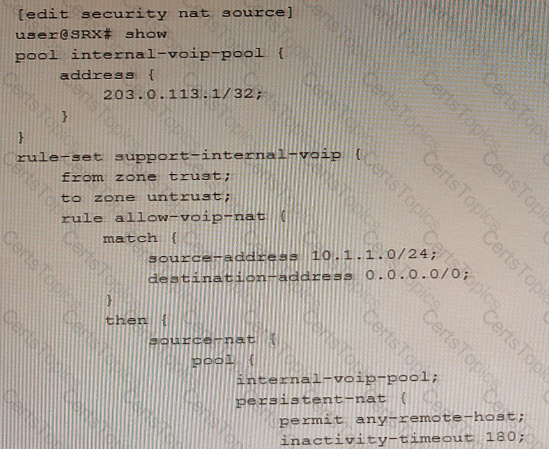
Referring to the exhibit, an internal host is sending traffic to an Internet host using the 203.0.113.1 reflexive address with source port 54311.
Which statement is correct in this situation?
Which two types of source NAT translations are supported in this scenario? (Choose two.)
Exhibit

You configure a traceoptions file called radius on your returns the output shown in the exhibit
What is the source of the problem?
Exhibit

Referring to the exhibit, which three protocols will be allowed on the ge-0/0/5.0 interface? (Choose three.)
Your company uses non-Juniper firewalls and you are asked to provide a Juniper solution for zero-day malware protection. Which solution would work in this scenario?
You are asked to share threat intelligence from your environment with third party tools so that those
tools can be identify and block lateral threat propagation from compromised hosts.
Which two steps accomplish this goal? (Choose Two)
You are asked to allocate security profile resources to the interconnect logical system for it to work properly.
In this scenario, which statement is correct?
Exhibit
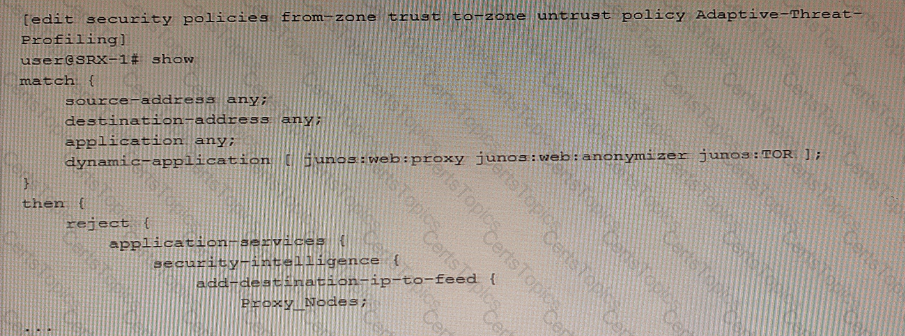
Referring to the exhibit, which two statements are true? (Choose two.)
Exhibit

Your company recently acquired a competitor. You want to use using the same IPv4 address space as your company.
Referring to the exhibit, which two actions solve this problem? (Choose two)
Exhibit
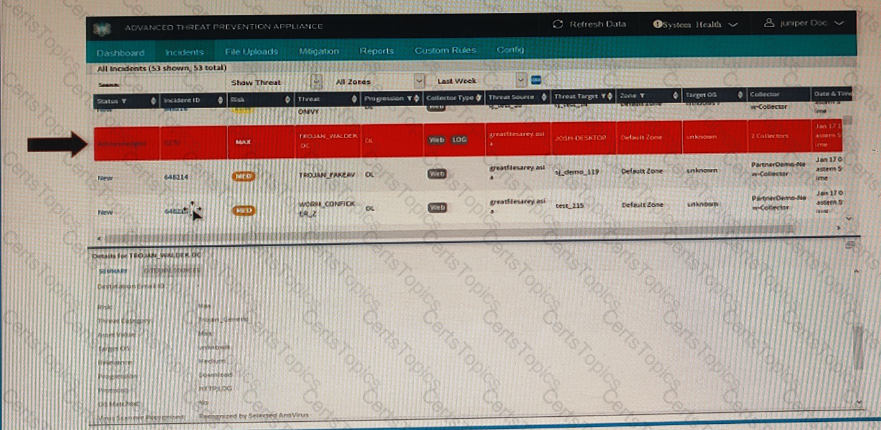
Exhibit.
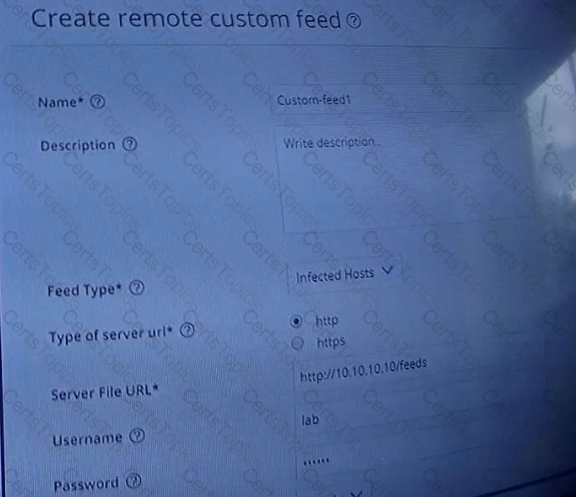
Referring to the exhibit, which two statements are true? (Choose two.)
Exhibit
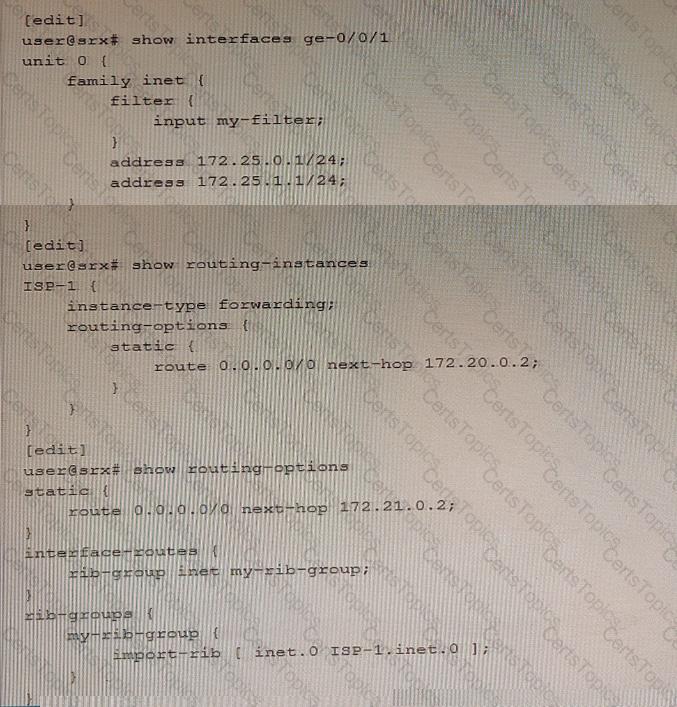
You are implementing filter-based forwarding to send traffic from the 172.25.0.0/24 network through ISP-1 while sending all other traffic through your connection to ISP-2. Your ge-0/0/1 interface connects to two networks, including the 172.25.0.0/24 network. You have implemented the configuration shown in the exhibit. The traffic from the 172.25.0.0/24 network is being forwarded as expected to 172.20.0.2, however traffic from the other network (172.25.1.0/24) is not being forwarded to the upstream 172.21.0.2 neighbor.
In this scenario, which action will solve this problem?
You have noticed a high number of TCP-based attacks directed toward your primary edge device. You are asked to
configure the IDP feature on your SRX Series device to block this attack.
Which two IDP attack objects would you configure to solve this problem? (Choose two.)
Regarding IPsec CoS-based VPNs, what is the number of IPsec SAs associated with a peer based upon?
Exhibit.
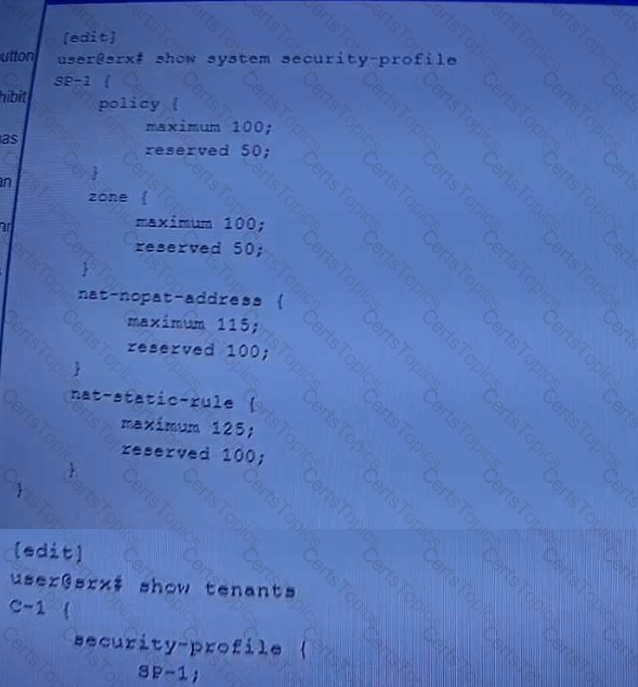
Referring to the exhibit, which two statements are true? (Choose two.)
Click the Exhibit button.
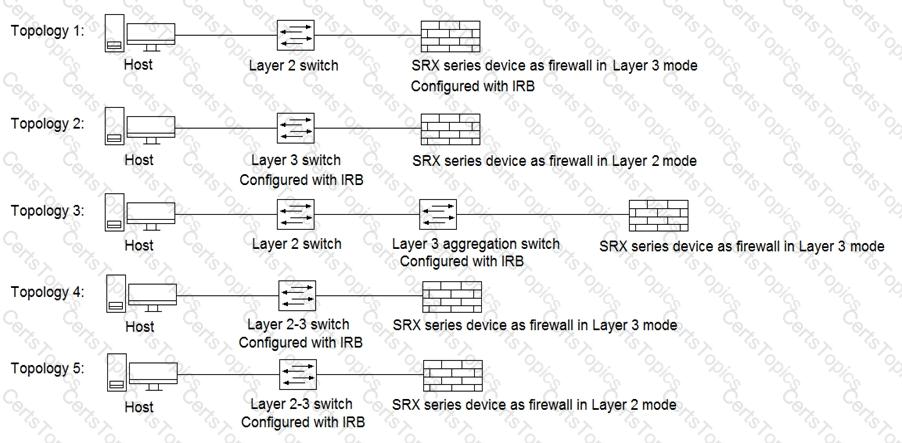
Referring to the exhibit, which three topologies are supported by Policy Enforcer? (Choose three.)
Which three type of peer devices are supported for Cos-Based IPsec VPN?
Exhibit
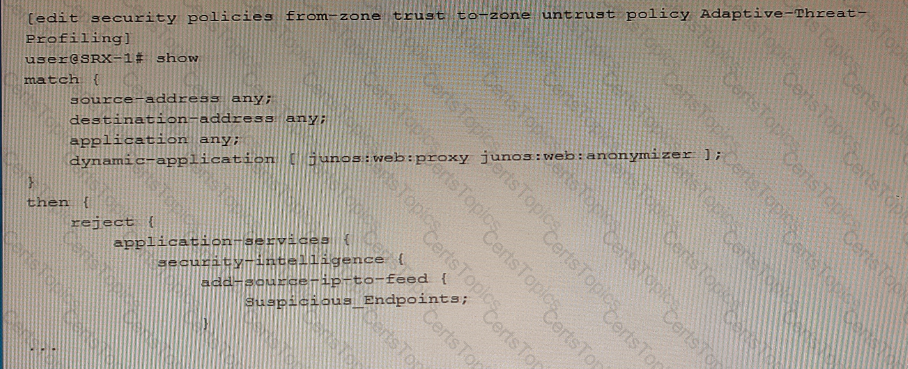
Referring to the exhibit, which two statements are true? (Choose two.)
In Juniper ATP Cloud, what are two different actions available in a threat prevention policy to deal with an infected host? (Choose two.)
You must implement an IPsec VPN on an SRX Series device using PKI certificates for authentication. As part of the implementation, you are required to ensure that the certificate submission, renewal, and retrieval processes are handled
automatically from the certificate authority.
In this scenario, which statement is correct.
Exhibit
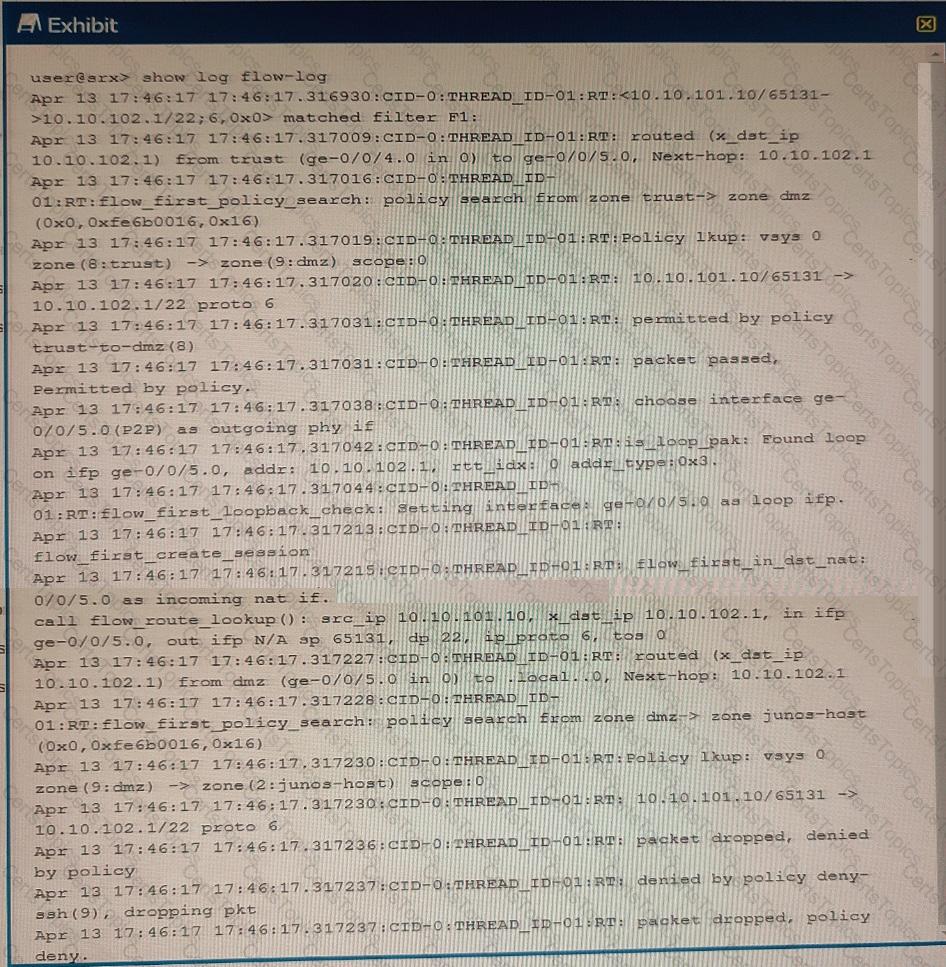
You are using traceoptions to verify NAT session information on your SRX Series device. Referring to the exhibit, which two statements are correct? (Choose two.)
Exhibit
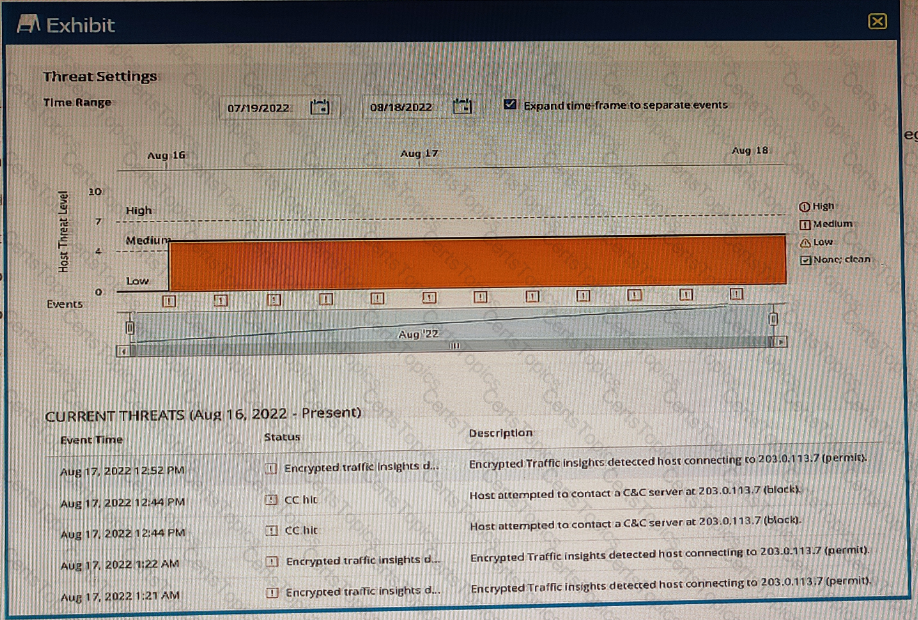
You are using ATP Cloud and notice that there is a host with a high number of ETI and C&C hits sourced from the same investigation and notice that some of the events have not been automatically mitigated.
Referring to the exhibit, what is a reason for this behavior?
You configured a chassis cluster for high availability on an SRX Series device and enrolled this HA cluster with the Juniper ATP Cloud. Which two statements are correct in this scenario? (Choose two.)
Exhibit
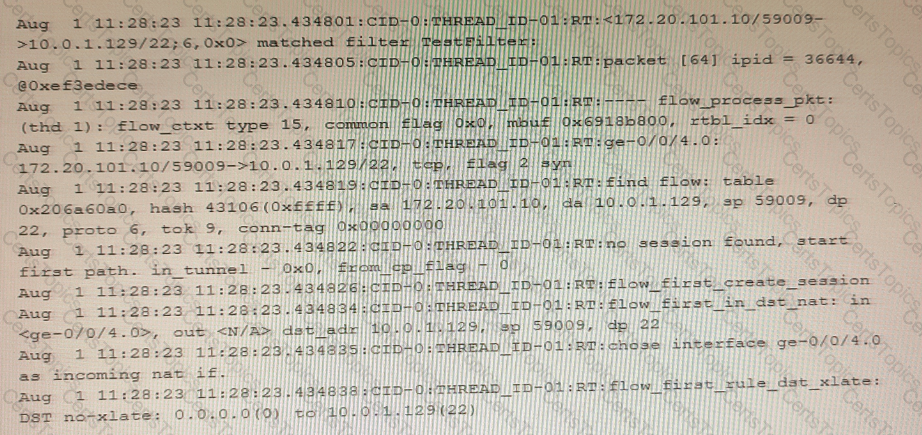
The exhibit shows a snippet of a security flow trace.
In this scenario, which two statements are correct? (Choose two.)
You opened a support ticket with JTAC for your Juniper ATP appliance. JTAC asks you to set up access to the device
using the reverse SSH connection.Which three setting must be configured to satisfy this request? (Choose three.)
You are connecting two remote sites to your corporate headquarters site. You must ensure that all traffic is secured and sent directly between sites In this scenario, which VPN should be used?
Exhibit

You configure Source NAT using a pool of addresses that are in the same subnet range as the external ge-0/0/0 interface on your vSRX device. Traffic that is exiting the internal network can reach external destinations, but the return traffic is being dropped by the service provider router.
Referring to the exhibit, what must be enabled on the vSRX device to solve this problem?
You are asked to detect domain generation algorithms
Which two steps will accomplish this goal on an SRX Series firewall? (Choose two.)
According to the log shown in the exhibit, you notice the IPsec session is not establishing.
What is the reason for this behavior?
you configured a security policy permitting traffic from the trust zone to the untrust zone but your
traffic not hitting the policy.
In this scenario, which cli command allows you to troubleshoot traffic problem using the match criteria?
Which two statements are correct regarding tenant systems on SRX Series devices? (Choose two.)
You are asked to provide single sign-on (SSO) to Juniper ATP Cloud. Which two steps accomplish this goal? (Choose two.)
You are asked to deploy filter-based forwarding on your SRX Series device for incoming traffic sourced from the 10.10 100 0/24 network in this scenario, which three statements are correct? (Choose three.)
SRX Series device enrollment with Policy Enforcer fails To debug further, the user issues the following command show configuration services security—intelligence url
https : //cloudfeeds . argon . juniperaecurity . net/api/manifeat. xml
and receives the following output:
What is the problem in this scenario?